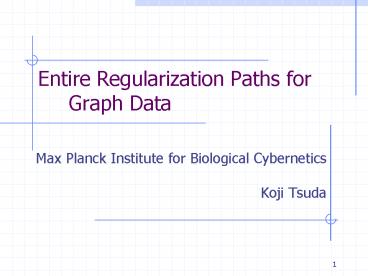Entire Regularization Paths for Graph Data - PowerPoint PPT Presentation
1 / 21
Title:
Entire Regularization Paths for Graph Data
Description:
1. Entire Regularization Paths for Graph Data. Max Planck Institute for Biological ... Trace the solution trajectory of L1-regularized learning ... – PowerPoint PPT presentation
Number of Views:48
Avg rating:3.0/5.0
Title: Entire Regularization Paths for Graph Data
1
Entire Regularization Paths for Graph Data
- Max Planck Institute for Biological Cybernetics
- Koji Tsuda
2
Graph Regression
Test
Training
3
Substructure Representation
- 0/1 vector of pattern indicators
- Huge dimensionality!
- Need feature selection
patterns
4
Overview
- Entire regularization paths
- LARS-LASSO (Efron et al., 2004), L1SVM
- Forward selection of features
- Trace the solution trajectory of L1-regularized
learning - Path following algorithm for graph data
- Feature search -gt pattern search
- Branch-and-bound algorithm
- DFS code tree, New Bound
5
Path Following Algorithms
- LASSO regression
- Follow the complete trajectory of
- Infinity to Zero
- Active feature set
- Features corresponding to nonzero weights
6
Piecewise Linear Path
- At a turning point,
- A new feature included into the active set, or
- An existing feature excluded from the active set
7
Practical Merit of Path Following
- Cross validation by grid search
- Has to solve QP many times
- Especially time-consuming for graph data
- Path following does not include QP
- Determine the CV-optimal regularization parameter
in the finest precision
8
Pseudo code of path following
- Set initial point and direction
- Do
- d1 Step size if next event is inclusion
- d2 Step size if next event is exclusion
- d min(d1,d2)
- Update the active feature set
- Set the next direction
- Until all features are included
9
Feature space of patterns
- Graph training data
- Set of all subgraphs (patterns)
- Each graph is represented as
10
Main Search problem
- Step size if pattern t is included next
- Find pattern that minimizes
constants computed from active set
11
Tree-shaped Search Space
- Each node has a pattern
- Generate nodes from the root
- Add an edge at each step
12
Tree Pruning
- If it is guaranteed that the optimal pattern is
not in the downstream, the search tree can be
pruned
Not generated
13
Theorem (Pruning condition)
- Traversed up to pattern t
- Minimum value so far
- No better pattern in the downstream, if
where
14
Reusing the search space
- Main search is solved repeatedly with different
parameters - More efficient to reuse the search space in next
iterations - Node generation is expensive due to the minimum
DFS code check - Whole tree of patterns is kept in memory and
progressively extended
15
Experiments
- Naïve Method
- Enumerate all patterns whose edge size is smaller
than maxpat - Then, LAR-LASSO is applied
- CPDB dataset
- 683 training graphs (chemical compounds)
- Classification dataset (mutagenetic or not)
- Converted to regression problem (y1,-1)
16
How to measure the computational cost of our
method
- Data divided into 90 train and 10 validation
- Record
- Number of nodes in tree
- Computation time
- at the point of minimum validation error
17
Computational Cost
18
Solution Path
19
Events
20
Conclusion
- Path following implemented for graph data
- Pattern search by the DFS code tree
- Hinge loss To do
- Search criterion more complicated
- Easily combined with itemset mining, tree mining,
sequence mining
21
gboost MATLAB toolbox
- Graph classification by LPBoost DFS Code Tree
- Includes an implementation of gspan
- www.kyb.mpg.de/people/nowozin/gboost
- Path following code will be available soon































